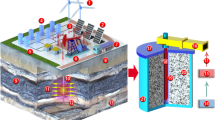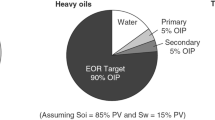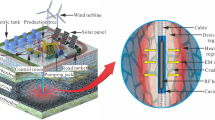Abstract
The heating process of water and oil using microwave oven with rectangular wave guide is investigated numerically and experimentally. The numerical model is validated with an experimental study. The transient Maxwell’s equations are solved by using the finite difference time domain method to describe the electromagnetic field in the wave guide and sample. The temperature profiles and velocity field within sample are determined by the solution of the momentum, energy, and Maxwell’s equations. In this study, the effects of physical parameters, e.g., microwave power, the position of sample in wave guide, size, and thickness of sample, are studied. The results of distribution of electric field, temperature profiles, and velocity field are presented in details. The results show that the mathematical models are in agreement with the experimental data. Conclusively, the mathematical model presented in this study correctly explains the phenomena of microwave heating within the liquid layer.


















Similar content being viewed by others
Abbreviations
- C p :
-
specific heat capacity [J/(kg K)]
- E :
-
electric field intensity (V/m)
- f :
-
frequency of incident wave (Hz)
- g :
-
gravitational constant (m/s2)
- H :
-
magnetic field intensity (A/m)
- P :
-
power (W)
- p :
-
pressure (Pa)
- Q :
-
local electromagnetic heat generation term (W/m3)
- s :
-
Poynting vector (W/m2)
- T :
-
temperature (°C)
- t :
-
time (s)
- tan δ:
-
dielectric loss coefficient (−)
- u,w :
-
velocity component (m/s)
- Z H :
-
wave impedance (Ω)
- Z l :
-
intrinsic impedance (Ω)
- α:
-
thermal diffusivity (m2/s)
- β:
-
coefficient of thermal expansion (1/K)
- η :
-
absolute viscosity (Pa s)
- ε :
-
permittivity (F/m)
- λ :
-
wavelength (m)
- μ :
-
magnetic permeability (H/m)
- υ :
-
velocity of propagation (m/s)
- ν :
-
kinematics viscosity (m2/s)
- ρ :
-
density (kg/m3)
- σ :
-
electric conductivity (S/m)
- ω :
-
angular frequency (rad/s)
- ξ :
-
surface tension (N/m)
- \(\infty \) :
-
ambient condition
- a:
-
air
- j :
-
layer number
- in:
-
input
- w:
-
water
References
Aparna, K., Basak, T., & Balakrishnan, A. R. (2007). Role of metallic and composite (ceramic–metallic) supports on microwave heating porous dielectrics. International Journal of Heat and Mass Transfer, 50, 3072–3089. doi:10.1016/j.ijheatmasstransfer.2006.11.021.
Ayappa, K. G., Brandon, S., et al. (1994). Microwave driven convection in a square cavity. AIChE Journal, 40(7), 1268–1272. doi:10.1002/aic.690400718.
Basak, T. (2003). Analysis of resonance during microwave thawing of slabs. International Journal of Heat and Mass Transfer, 46, 4279–4301. doi:10.1016/S0017-9310(03)00212-6.
Basak, T. (2004). Role of resonance on microwave heating of oil–water emusions. AIChE Journal, 50, 2659–2675. doi:10.1002/aic.10207.
Basak, T., & Ayappa, K. G. (2002). Role of length scales on microwave thawing dynamics in 2D cylinders. International Journal of Heat and Mass Transfer, 45(23), 4543–4559. doi:10.1016/S0017-9310(02)00171-0.
Boyacı, İ. H., Sumnu, G., & Sakiyan, O. (2009). Estimation of dielectric properties of cakes based on porosity, moisture content, and formulations using statistical methods and artificial neural networks. Food Bioprocess Technology. doi:10.1007/s11947-008-0064-z
Chatterjee, S., Basak, T., & Das, S. K. (2007). Microwave driven convection in a rotating cylindrical cavity, A numerical study. Journal of Food Engineering, 79, 1269–1279. doi:10.1016/j.jfoodeng.2006.04.039.
Curet, S., Rouaud, O., & Boillereaux, L. Microwave tempering and heating in a single-mode cavity: Numerical and experimental investigations. Chemical Engineering and Processing, 47, 1656–1665.
Datta, A. K., Prosetya, H., & Hu, W. (1992). Mathematical modeling of batch heating of liquids in a microwave cavity. Journal of Microwave Power and Electromagnetic Energy, 27, 38–48.
Dibben, D. C., & Metaxas, A. C. (1997). Frequency domain vs. time domain finite element methods for calculation of fields in multimode cavities. IEEE Transactions on Magnetics, 33(2), 1468–1471. doi:10.1109/20.582537.
Huo, Y., Li, B. Q., & Tang, J. (2004). Boundary/finite edge element modeling of 3-D microwave thermal food processing. ASME, Heat Transfer Division, (Publication) HTD 375 (1), Art. No. IMECE2004-59670, pp. 687–694.
Jia, X., & Bialkowski, M. (1992). Simulation of microwave field and power distribution in a cavity by a three dimension finite element method. Journal of Microwave Power and Electromagnetic Energy, 27(1), 11–22.
Liu, F., Turner, I., & Bialowski, M. (1994). A finite-difference time-domain simulation of power density distribution in a dielectric loaded microwave cavity. Journal of Microwave Power and Electromagnetic Energy, 29(3), 138–147.
Mur, G. (1981). Absorbing boundary conditions for the finite-difference approximation of the time-domain electromagnetic-field equations. IEEE Transactions on Electromagnetic Compatibility EMC-23, 4, 377–382. doi:10.1109/TEMC.1981.303970.
Patankar, S. V. (1980). Numerical heat transfer and fluid flow. New York: Henisphere.
Ratanadecho, P., Aoki, K., & Akahori, M. (2002a). A numerical and experimental investigation of the modeling of microwave heating for liquid layers using a rectangular wave guide (effects of natural convection and dielectric properties). Applied Mathematical Modelling, 26, 449–472. doi:10.1016/S0307-904X(01)00046-4.
Ratanadecho, P., Aoki, K., & Akahori, M. (2002b). Experimental validation of a combined electromanetic and thermal model for a microwave heating of multi-layered materials using a rectangular wave guide. ASME Journal of Heat and Transfer, 124(5), 992–996. doi:10.1115/1.1495521.
Rattanadecho, P. (2006). The simulation of microwave heating of wood using a rectangular wave guide: Influence of frequency and sample size. Chemical Engineering Science, 61, 4798–4811. doi:10.1016/j.ces.2006.03.001.
Rattanadecho, P., Kazuo, A., & Masatoshi, A. (2002). The characteristics of microwave melting of frozen packed beds using a rectangular wave guide. IEEE Transactions on Microwave Theory and Technique, 50(6), 1487–1494. doi:10.1109/TMTT.2002.1006410.
Rattanadecho, P., & Suwannapum, N. (2009). Interactions between electromagnetic and thermal fields in microwave heating of hardened type I-cement paste using a rectangular wave guide (influence of frequency and sample size). ASME Journal of Heat and Transfer (in press).
Tada, S., Echigo, R., & Yoshida, H. (1997). Numerical analysis of electromagnetic wave in a partially loaded microwave applicator. International Journal of Heat and Mass Transfer, 41, 709–718. doi:10.1016/S0017-9310(97)00164-6.
Vadivambal, R., & Jayas, D. S. (2009). Non-uniform temperature distribution during microwave heating of food materials—A review. Food Bioprocess Technology. doi:10.1007/s11947-008-0136-0
Yee, K. S. (1996). Numerical solution of initial boundary value problems involving Maxwell’s equation in isotropic media. IEEE Transactions on Antennas and Propagation, 14, 302–307.
Zhang, Q., Jackson, T. H., & Ungan, A. (2000). Numerical modeling of microwave induced natural convection. International Journal of Heat and Mass Transfer, 43, 2141–2154. doi:10.1016/S0017-9310(99)00281-1.
Zhu, J., Kuznetsov, A. V., & Sandeep, K. P. (2007). Mathematical modeling of continuous flow microwave heating of liquid (effect of dielectric properties and design parameters). International Journal of Thermal Sciences, 46, 328–341. doi:10.1016/j.ijthermalsci.2006.06.005.
Acknowledgement
The authors gratefully acknowledge the financial support provided by The Thailand Research Fund for the simulation facilities described in this paper.
Author information
Authors and Affiliations
Corresponding author
Rights and permissions
About this article
Cite this article
Cha-um, W., Rattanadecho, P. & Pakdee, W. Experimental and Numerical Analysis of Microwave Heating of Water and Oil Using a Rectangular Wave Guide: Influence of Sample Sizes, Positions, and Microwave Power. Food Bioprocess Technol 4, 544–558 (2011). https://doi.org/10.1007/s11947-009-0187-x
Received:
Accepted:
Published:
Issue Date:
DOI: https://doi.org/10.1007/s11947-009-0187-x




